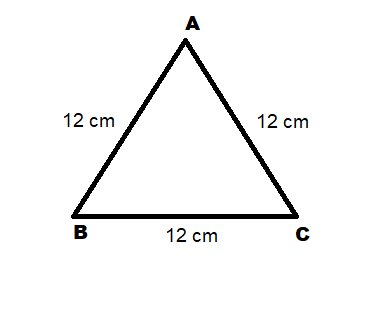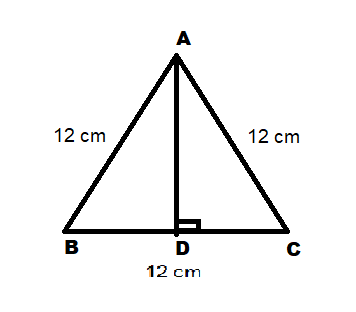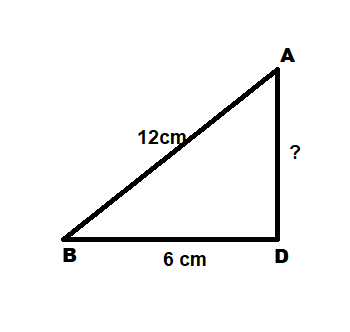
The sides of an equilateral triangle ABC are 12 cm each , D is the foot of the perpendicular from A to BC and E is the midpoint of AD. Then BE is
A.$4\sqrt 3 $cm
B.$6\sqrt 2 $cm
C.$\sqrt {63} $cm
D.None of these
Answer
581.7k+ views
Hint: Since we are given an equilateral triangle ABC and AD is perpendicular to BC. By using the property the height of an equilateral triangle bisects its base we get BD=6cm and then by using Pythagoras theorem we can find AD and then considering the small triangle BDE and using Pythagoras theorem we can find BE
Complete step-by-step answer:
Given ABC is an equilateral triangle .
Hence all its sides are equal.

And it's also given that D is the foot of the perpendicular from A to BC
It means that AD is perpendicular to BC

Step 2 :
Since ABC is an equilateral triangle , we know that the height or altitude of an equilateral triangle bisects its base.
Here AD is the height of the triangle .
Therefore it bisects the base and now we have BD=BC=6cm
Step 3:
Now let's find AD by using Pythagoras theorem
Consider the triangle ABD . It is a right triangle .

By using Pythagoras theorem
$
\Rightarrow {({\text{Hypotenuse }})^2} = {\text{ Sum of squares of other two sides}} \\
\Rightarrow {\left( {AB} \right)^2} = {\left( {AD} \right)^2} + {\left( {BD} \right)^2} \\
\Rightarrow {12^2} = {\left( {AD} \right)^2} + {6^2} \\
\Rightarrow 144 = {\left( {AD} \right)^2} + 36 \\
\Rightarrow 144 - 36 = {\left( {AD} \right)^2} \\
\Rightarrow 108 = {\left( {AD} \right)^2} \\
\Rightarrow AD = \sqrt {108} \\
$
Now we have that $AD = \sqrt {108} cm$
Step 4 :
We are given that E is the midpoint of AD.

Since E is the midpoint of AD , we have AE=ED=$\frac{{\sqrt {108} }}{2}$cm
We need to find BE , so let's consider the right triangle BDE
Lets use Pythagoras theorem to find BE
\[
\Rightarrow {({\text{Hypotenuse }})^2} = {\text{ Sum of squares of other two sides}} \\
\Rightarrow {\left( {BE} \right)^2} = {\left( {ED} \right)^2} + {\left( {BD} \right)^2} \\
\Rightarrow {\left( {BE} \right)^2} = {\left( {\frac{{\sqrt {108} }}{2}} \right)^2} + {6^2} \\
\Rightarrow {\left( {BE} \right)^2} = \frac{{108}}{4} + 36 \\
\\
\]
Now by taking lcm we get
$
\Rightarrow {\left( {BE} \right)^2} = \frac{{108 + 144}}{4} \\
\Rightarrow {\left( {BE} \right)^2} = \frac{{252}}{4} \\
\Rightarrow {\left( {BE} \right)^2} = 63 \\
\Rightarrow BE = \sqrt {63} cm \\
$
Therefore $BE = \sqrt {63} cm$
The correct option is C
Note: The sides of an equilateral triangle are congruent.
An equilateral triangle is a special case of a triangle where all 3 sides have equal length and all 3 angles are equal to 60 degrees.
Complete step-by-step answer:
Given ABC is an equilateral triangle .
Hence all its sides are equal.

And it's also given that D is the foot of the perpendicular from A to BC
It means that AD is perpendicular to BC

Step 2 :
Since ABC is an equilateral triangle , we know that the height or altitude of an equilateral triangle bisects its base.
Here AD is the height of the triangle .
Therefore it bisects the base and now we have BD=BC=6cm
Step 3:
Now let's find AD by using Pythagoras theorem
Consider the triangle ABD . It is a right triangle .

By using Pythagoras theorem
$
\Rightarrow {({\text{Hypotenuse }})^2} = {\text{ Sum of squares of other two sides}} \\
\Rightarrow {\left( {AB} \right)^2} = {\left( {AD} \right)^2} + {\left( {BD} \right)^2} \\
\Rightarrow {12^2} = {\left( {AD} \right)^2} + {6^2} \\
\Rightarrow 144 = {\left( {AD} \right)^2} + 36 \\
\Rightarrow 144 - 36 = {\left( {AD} \right)^2} \\
\Rightarrow 108 = {\left( {AD} \right)^2} \\
\Rightarrow AD = \sqrt {108} \\
$
Now we have that $AD = \sqrt {108} cm$
Step 4 :
We are given that E is the midpoint of AD.

Since E is the midpoint of AD , we have AE=ED=$\frac{{\sqrt {108} }}{2}$cm
We need to find BE , so let's consider the right triangle BDE
Lets use Pythagoras theorem to find BE
\[
\Rightarrow {({\text{Hypotenuse }})^2} = {\text{ Sum of squares of other two sides}} \\
\Rightarrow {\left( {BE} \right)^2} = {\left( {ED} \right)^2} + {\left( {BD} \right)^2} \\
\Rightarrow {\left( {BE} \right)^2} = {\left( {\frac{{\sqrt {108} }}{2}} \right)^2} + {6^2} \\
\Rightarrow {\left( {BE} \right)^2} = \frac{{108}}{4} + 36 \\
\\
\]
Now by taking lcm we get
$
\Rightarrow {\left( {BE} \right)^2} = \frac{{108 + 144}}{4} \\
\Rightarrow {\left( {BE} \right)^2} = \frac{{252}}{4} \\
\Rightarrow {\left( {BE} \right)^2} = 63 \\
\Rightarrow BE = \sqrt {63} cm \\
$
Therefore $BE = \sqrt {63} cm$
The correct option is C
Note: The sides of an equilateral triangle are congruent.
An equilateral triangle is a special case of a triangle where all 3 sides have equal length and all 3 angles are equal to 60 degrees.
Recently Updated Pages
Master Class 12 Business Studies: Engaging Questions & Answers for Success

Master Class 12 Economics: Engaging Questions & Answers for Success

Master Class 12 English: Engaging Questions & Answers for Success

Master Class 12 Maths: Engaging Questions & Answers for Success

Master Class 12 Social Science: Engaging Questions & Answers for Success

Master Class 12 Chemistry: Engaging Questions & Answers for Success

Trending doubts
Which places in India experience sunrise first and class 9 social science CBSE

Fill the blanks with the suitable prepositions 1 The class 9 english CBSE

Write the 6 fundamental rights of India and explain in detail

Difference Between Plant Cell and Animal Cell

What is the Full Form of ISI and RAW

Golden Revolution is related to AFood production BOil class 9 social science CBSE




